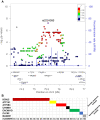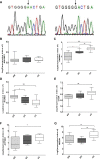X-chromosome variants are associated with aldosterone producing adenomas
- PMID: 34006971
- PMCID: PMC8131628
- DOI: 10.1038/s41598-021-89986-8
X-chromosome variants are associated with aldosterone producing adenomas
Abstract
Aldosterone-producing adenomas (APAs) are a major cause of primary aldosteronism (PA) and are characterized by constitutively producing aldosterone, which leads to hypertension. Several mutations have been identified in ion channels or ion channel-associated genes that result in APAs. To date, no studies have used a genome-wide association study (GWAS) approach to search for predisposing loci for APAs. Thus, we investigated Scandinavian APA cases (n = 35) and Swedish controls (n = 60) in a GWAS and discovered a susceptibility locus on chromosome Xq13.3 (rs2224095, OR = 7.9, 95% CI = 2.8-22.4, P = 1 × 10-7) in a 4-Mb region that was significantly associated with APA. Direct genotyping of sentinel SNP rs2224095 in a replication cohort of APAs (n = 83) and a control group (n = 740) revealed persistently strong significance (OR = 6.1, 95% CI = 3.5-10.6, p < 0.0005). We sequenced an adjacent gene, MAGEE1, of the sentinel SNP and identified a rare variant in one APA, p.Gly327Glu, which is complementary to other mutations in our primary cohort. Expression quantitative trait loci (eQTL) were investigated on the X-chromosome, and 24 trans-eQTL were identified. Some of the genes identified by trans-eQTL point towards a novel mechanistic explanation for the association of the SNPs with APAs. In conclusion, our study provides further insights into the genetic basis of APAs.
Conflict of interest statement
The authors declare no competing interests.
Figures



Similar articles
-
Endometrial vezatin and its association with endometriosis risk.Hum Reprod. 2016 May;31(5):999-1013. doi: 10.1093/humrep/dew047. Epub 2016 Mar 22. Hum Reprod. 2016. PMID: 27005890
-
Genetic and epigenetic analyses of aldosterone-producing adenoma with hypercortisolemia.Steroids. 2019 Nov;151:108470. doi: 10.1016/j.steroids.2019.108470. Epub 2019 Aug 7. Steroids. 2019. PMID: 31400391
-
Somatic mutations affecting the selectivity filter of KCNJ5 are frequent in 2 large unselected collections of adrenal aldosteronomas.Hypertension. 2012 Mar;59(3):587-91. doi: 10.1161/HYPERTENSIONAHA.111.186239. Epub 2012 Jan 17. Hypertension. 2012. PMID: 22252394
-
Unravelling the Genetic Basis of Primary Aldosteronism.Nutrients. 2021 Mar 8;13(3):875. doi: 10.3390/nu13030875. Nutrients. 2021. PMID: 33800142 Free PMC article. Review.
-
Unanswered Questions in the Genetic Basis of Primary Aldosteronism.Horm Metab Res. 2017 Dec;49(12):963-968. doi: 10.1055/s-0043-120066. Epub 2017 Oct 24. Horm Metab Res. 2017. PMID: 29065434 Review.
References
-
- Funder, J. W. et al. The Management of Primary Aldosteronism: Case Detection, Diagnosis, and Treatment: An Endocrine Society Clinical Practice Guideline. J Clin Endocrinol Metab101, 1889-1916, 10.1210/jc.2015-4061 (2016). - PubMed
Publication types
MeSH terms
Substances
LinkOut - more resources
Full Text Sources
Other Literature Sources
Miscellaneous

